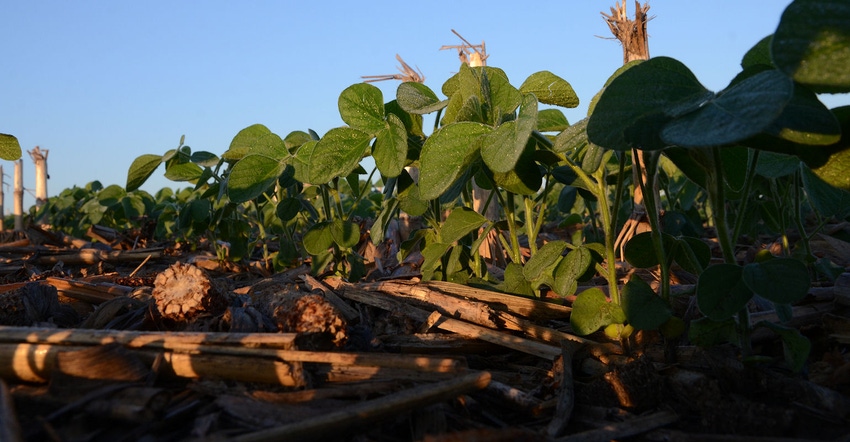April 15, 2020

The world is in pandemic turmoil, but livestock and people still must eat, and it turns out U.S. producers are ready to fill that need. At least that's the message being delivered during this week's U.S. Soy Connection: Global Digital Conference and Situation Report. Leaders from the U.S. Soybean Export Council briefed media during that conference about key issues impacting the industry.
Jim Sutter, CEO, USSEC, shared that the global pandemic presents an evolving situation to global trade, yet during the digital conference there was one clear message: "The U.S. soybean industry is open for business and our entire chain is working to provide a sustainable, safe and reliable supply of soybeans for global customers."
With agriculture named a critical infrastructure, that helps producers keep moving product from farm to container to key markets. During the call, representatives from different markets USSEC serves were on hand. A key message is that the hotel, restaurant, institutional food market changes are not leaving soybeans unscathed. This HRI segment is impacting soybean oil demand.
For example, in Japan and South Korea, markets where consumers are more likely to dine out, the demand has slid 5 to 10% even though these are significant soy foods markets. "In Japan and Korea the consumers do not do as much cooking at home as other cultures," says Roz Leeck, senior director, market access and regional director, North Asia region. "There is a bit of a shift in the diets."
Yet in other markets, consumers are turning to poultry, pork and eggs for their diets, which are all good consumers of soybeans.
Brent Babb, regional director, Greater Europe and Middle East/North Africa, shared this region accounts for 21% of soybean exports and so far, soybean sales remain stable there. "We're seeing the supply chain to continue to work. The ports are working, though there are some minor exceptions, and the feed industry supply remains good," he says.
The virtual conference, which has drawn more than 2,000 from around the world, does have several participants concerned about supply. Babb says that USSEC continues to communicate with customers to deal with those "minor anxieties."
U.S. farmers know there's an ample supply of soybeans on hand to serve the market, the key is whether the market is buying, which means looking at China.
Phase 1 and more
China trade has been top of mind at the USSEC conference and Sutter explains that the takeaway from key industry experts is optimism that China will meet its Phase 1 agreed import targets, perhaps with a slight delay.
He explains that when the agreement was signed, many thought the spigot would just turn on and ag products would flow toward China. It doesn't quite work that way. "A lot had to happen including the ability for importers to get a tariff waiver to import," he says. "That's a very important first step."
Those waivers have been issued, which can open the door to more purchases. But that window has opened just as Brazilian soybeans are reaching the market, which get a benefit from the weak currency in that country. Brazil is aggressively selling its crop as its harvested, which pushes aside other suppliers.
"The opinion of the experts is that by the middle of this year – and there are varying dates depending on the expert – which is May to August, the Chinese would move to source soybeans from here," Sutter says.
The key is that this will be a calendar year sale, which puts some of those sales into the next marketing year for U.S. product. However, Sutter adds that demand is good and that the African Swine Fever situation is improving and may be "improving faster than it was expected to."
China did draw down its soybean stocks, and whether that pile, which is 10 million tons will be replenished remains to be seen. However, Sutter is optimistic. "Will they replenish? Yes, we believe they will," he says. "The maintenance of these strategic inventory stocks is critical and we anticipate they will [restore that]."
Other issues explored
USSEC leaders also discussed the worry of displaced shipping containers, which is a problem that has built since the tariff situation fired up and has been exacerbated by the pandemic. However, Leeck explains that while this is a concern, it has not been a huge problem.
She says Korean importers have expressed a concern over the issue, but it has "not necessarily materialized," she says. "Buyers are looking at potentially converting to bulk shipments to get product delivered if there is a real container issue."
And what about the farm? Monte Peterson, USSEC chair, and a Valley City, N.D. farmer shares that the financial situation on the farm didn't just appear with the pandemic, but has been with the industry for a few years. He says the area he's heard the most concern about is younger producers who may not be as well established as veteran producers, but he was optimistic about the 2020 crop.
"I still think lenders are finding a way," Peterson says. "Yes, there's probably going to be some early retirement and some operations not able to be successful at continuing. But I do believe the lending industry has really stepped up to the plate."
As planters start to roll in earnest to get the 2020 crop of soybeans in, it appears work on exports continues. However, the benefits of Phase 1 of the China trade deal may not be felt until later this year. For now, it's about remaining socially distant while getting the crop in the ground to meet buyers' needs.
About the Author(s)
You May Also Like






